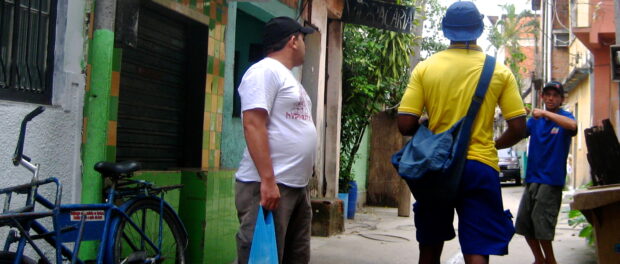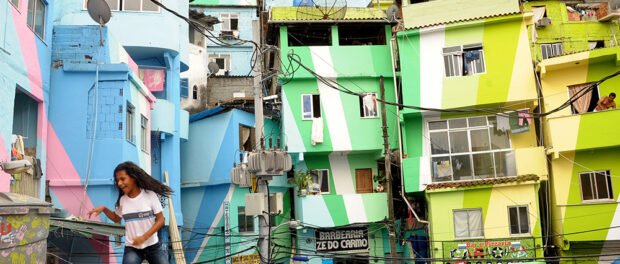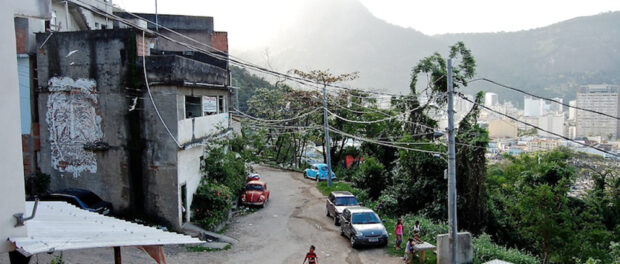
The informal geography and history of favelas can mean it is difficult for letters and packages to be delivered to residents. The creativity and entrepreneurship of favela residents have resulted in alternative community mailing services in some favelas. In other communities, residents still struggle to be recognized by the formal government and claim their right to mail service.
A community initiative
In Rocinha, the company Carteiro Amigo (Mailman Friend) has been delivering mail to residents’ homes since 2000. The system is simple: residents sign up for the service for a monthly price of $6 (R$16) per family and start using the company’s address as their own. Once their correspondence arrives, Carteiro Amigo mailmen deliver it to their doors. Around 30,000 homes are signed up for the service.
The company’s owners Elaine Vieira, Sila Vieira and Carlos Pedro da Silva noticed an access gap in their community. Despite receiving a Pacifying Police Unit in September 2012, around 70% of Rocinha, the largest favela in South America, has not been formally mapped by the government. As such, people do not receive their mail through government postal carriers.
“Our work is to deliver mail where the government hasn’t formally mapped,” explains Sila Vieira. “[Before] people had no way of receiving letters. They had no way of giving out an address. The person wants to buy something over the Internet, 30% or 40%–sometimes even 80%–cheaper than in a store and the person did not have that right. Today people can buy online and save money, and they have…an address. I think that’s the larger impact: the person knowing their address.”
The Carteiro Amigo initiative has been covered worldwide because of its work mapping the community and Google’s interest in the community map. The mapping happened gradually over a number of years: when a new client signs up for the service, a member of the staff accompanies them to their home so it can be added to the map. A large scale map now hangs proudly in Carteiro Amigo’s office in Rocinha.
The company has expanded to eight other communities that had the same problem, giving jobs to more than 20 people. Morro dos Macacos, Parque da Cidade, Asa Branca, Cantagalo, Vila das Canoas, Parque Royal, Praia da Rosa, Rio das Pedras, Mato Alto and Providência all boast Carteiro Amigo mailing services.
Although Carteiro Amigo has benefitted a number of communities that are slowly being mapped out by their staff, other communities struggle with the right of correspondence even when they have been formally mapped by the authorities.
Lack of service in a mapped community
Santa Marta was the first favela to receive a Police Pacifying Unit (UPP). Unlike many other communities, the pacification program has been generally positively seen in Santa Marta. In 2010 a large portion of the community was formally mapped: residents now had street names, house numbers and zip codes. In theory, Santa Marta residents should be able to receive their correspondence.
But according to resident and business owner Thiago Firmino, he rarely receives his letters at home, which complicates the administration of his Favela Santa Marta Tour business.
“[The mail service] was delivering in a few houses but most of the correspondence is delivered to the Neighborhood Association. It’s a mess. They don’t deliver bigger packages. They screw it up when it’s near the favela. I had to go get [my mail] several times. The secretary there separates everything, but anyone can go there and get it.”
The president of the Neighborhood Association, Zé Mario, says around 95% of Santa Marta’s correspondence is delivered to the Association, where there are no staff or resources to organize and deliver the letters.
“The mail here works like this: they deliver it to the Neighborhood Association and we used our own resources to prove that in Santa Marta, they have to deliver the mail at the residents’ houses but the mail service alleges there are no mailboxes in the houses,” explains Zé Mario. “The law says they have to deliver it. The Association has no obligation to do it, that’s their work. Nothing has been done, the law has to be followed. The residents here pay their taxes but we are still informal. Our rights are being taken away.”
A place ‘at risk’
Neuza Nascimento, whose community-based organization CIACAC serves children in Parque Jardim Beira Mar, part of unpacified Parada de Lucas, North Zone, has seen a shift in the mailing service in her community over the last few years. Before, residents had to pick up their letters and packages at the Neighborhood Association but now most houses receive mail normally.
“Years ago there was no mailman,” she said. “But the letters were given to the Neighborhood Association and we would pick it up there. Today, there’s an official mailman who comes to the community every day to bring all of our correspondence.”
However, the correspondence doesn’t always make it to the houses because parts of her community are considered to be ‘at risk.’
“It depends on the company that is delivering. Some packages aren’t delivered here because it’s considered a ‘risk’ area. In that case we receive a notice instructing us to go to the neighborhood’s mailing service office to pick it up.”
The fight for PO boxes
The community of Estradinha, located between Botafogo and Copacabana, got a free PO box service in September of this year after years fighting for the right to receive correspondence. Residents say letters and packages used to be delivered to a bar at the top of the community, Bar do Marrom.
“The mailman left the correspondence in a box, in the kiosk,” explained resident Dilma Pinto de Oliveira, 52, in a note on the UPP website. “Since there were a lot of letters, they disappeared or people took the envelopes by mistake.”
The 108 PO boxes have been servicing 500 people for the last two months. Residents who struggled to communicate through correspondence now have that right.
A self-guaranteed right
The range of solutions and issues that arise in the pursuit of the right to correspondence illustrates the diverse and dynamic nature of favelas. The right to communication is fought for in all favelas, in many different ways. Whether a group of community journalists delivering a local newspaper to houses in Maré, or a group of business owners mapping the largest of the city’s favelas by hand, one thing is conclusive: the right to communication is most often fulfilled by residents organizing it for themselves, not guaranteed as rights.



